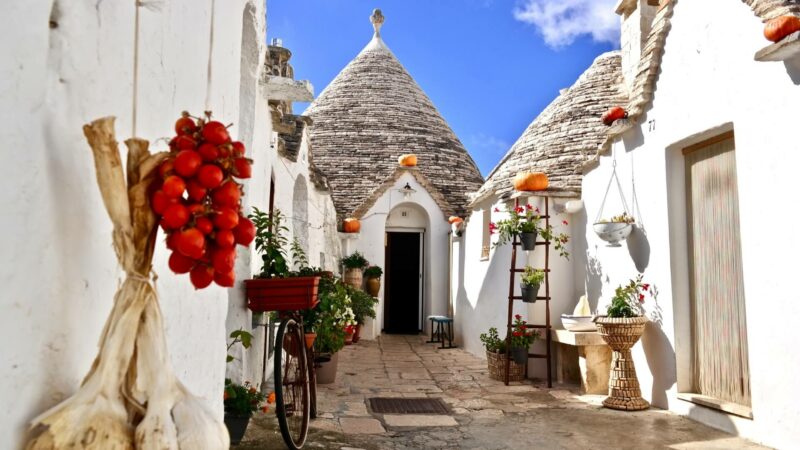Umbria, where getting lost means finding yourself in another era
Art and Crafts, Nature and History, all in uppercase: because in Umbria, these four elements, intertwining over the centuries, have played an essential role in the life of the people and the communities that have inhabited the region. The charm of unspoiled nature and the religious sentiment – following in the footsteps of monks, hermits, and religious orders like that of St. Francis – attracted artists and artisans from all over Italy. They chose Umbria as a natural stage for their activities, opening schools of painting, workshops for wood and textiles, and laboratories for glass and ceramics like those in Deruta. All these have shaped the history of the region and helped define Italian style. The same connection with lush nature also offers itself to the tourist of today. Between May and June every year tourists come from all over the world to Castelluccio to see the fields of lentil flowers. Castelluccio is a small village of 120 inhabitants surrounded by the mountains of the National Park of Monti Sibillini. In Campello on the Clitunno are the Fountains of the Clitunno, natural springs that emerge out of the rocks and have inspired countless poets and painters. It is impossible not to fall under the spell of the Marmore Waterfall’s beauty and that of the Lake Trasimeno. Here open-air sports become the central purpose of the trip for all those who wish to have fun sailing, biking, trekking, canoeing, and horse riding. For the lovers of the fantasy genre, the town of Narni inspired the Chronicles of Narnia. There is a long tunnel running under the city with the cunicles of a Roman aqueduct, part of a domus and the great room of torments. Here the Inquisition would question its victims.
The cities of Umbria: a journey through the centuries
In Perugia, one walks up and down along pedestrian paths winding through neighborhoods with historically evocative views. The Renaissance palaces and Medieval monuments set the stage for the splendid Piazza IV November. Here stands the city’s symbol, the Fontana Maggiore. Perugia has a youthful spirit, thanks to its historic university, and a jazz festival in July attracts enthusiasts from every corner of the globe. Perugia also offers mysterious underground paths that narrate stories of ancient peoples – Romans, Etruscans, Byzantines, and those of the medieval era. What to taste here? Obviously, the chocolate (Perugina is outstanding), is there to savor while enjoying the view from Rocca Paolina and the Etruscan Well. Next, there’s Gubbio, with a Gothic soul, known as the “grey city” due to its houses built with local limestone. Walking in the footsteps of millions of pilgrims, we find ourselves in the places known to St. Francis, the patron saint of Italy. Immersed in the spirituality of Assisi, the upper part of the town is dominated by the Basilica dedicated to the Saint, now a UNESCO World Heritage Site. This place, filled with history and spirituality, deserves a special stop to view the precious frescoes by Giotto and Cimabue.
The Basilica of S. Maria degli Angeli, with the Porziuncola Chapel, and the Church of San Damiano also deserve a visit. All around, the tranquility of the Sacred Grove inspires moments of meditation and rest. A half-hour drive and we reach Spoleto, dominated by the majestic Albornozian Fortress and the striking Bridge of Towers that stands out against the landscape. It is not far from Piazza Mercato or from the Foro, the heart of the historic center. Orvieto welcomes us with its imposing Cathedral, a masterpiece of Italian Gothic with its decorated facade and interior filled with artworks. Its Etruscan roots are hidden underground: a web of tunnels and caves is enriched by a series of sculptures and works of art carved in the tuff. Moving past three rings of walls, we find ourselves inside Todi with its breathtaking view on the Tiber valley. Todi invites us to discover the lively Piazza del Popolo and the Cathedral of S. Maria Annunziata. Likewise, Trevi has a peculiar winding structure, set among the century old olive groves of Umbria. In fact, it is known as “the Olive Oil City.” Foligno surprises us because of its Museum of Printing. It contains the first Gutenberg printed edition of Dante’s Divine Comedy.
The four pillars of Umbrian cuisine
If four are the elements that make the Umbrian territory stunning, there are also four products that make the regional cuisine special. First, there are wine and olive oil, with ancient origins dating back to the Umbrians and the Etruscans. The wine production methods, as well as the bold and structured flavors of Umbrian wine are certified by dedicated Wine Routes such as Cantico, Sagrantino, Colli of the Trasimeno, and Etrusco-Roman. Umbrian olive oil boasts a high quality that is unmatched in Italy for its excellent digestibility. However, the undisputed king of traditional Umbrian cuisine is pork, around which a true art has emerged. It is the norcineria – present in Norcia and Valnerina since the Middle Ages – which has reached unparalleled levels of excellence. In addition to the Norcia ham, the Norcini masters, invoking memories, techniques, rituals, and rhythms of tradition, also produce other cured meats such as corallina, sausages, porchetta, capocollo, and wild boar truffle salami. Speaking of truffles, their aromatic scent can be discovered in two species found in Umbria: the black truffle of Norcia and Spoleto and the white truffle of Eugubino-Gualdese.









